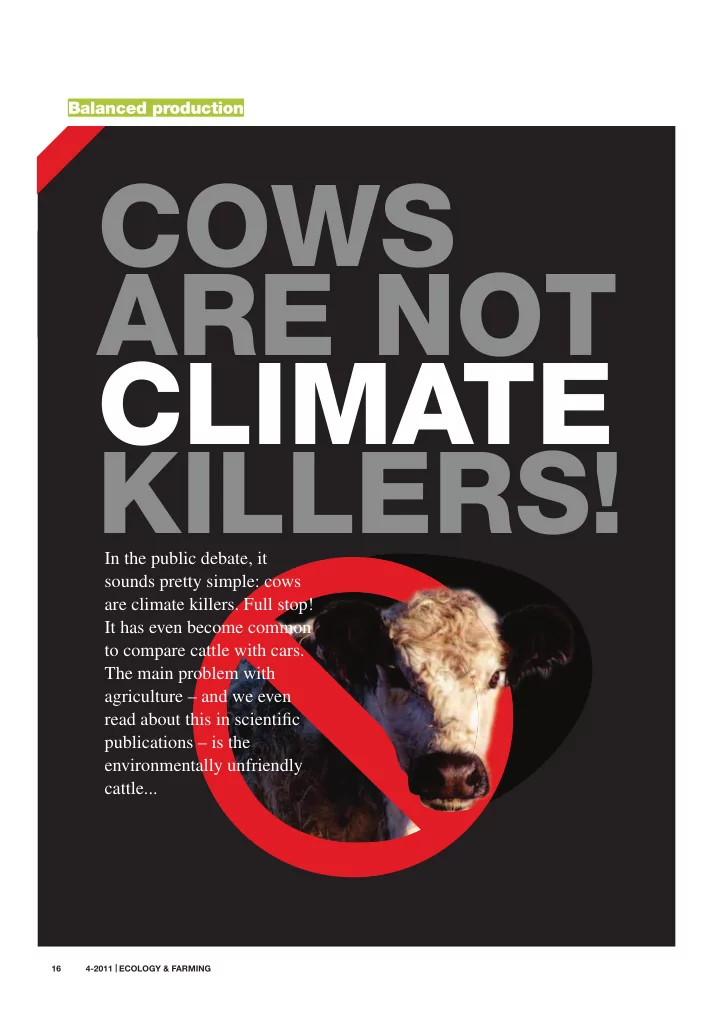

Balanced production COWS ARE NOT CLIMATE KILLERS! In the public debate, it sounds pretty simple: cows are climate killers. Full stop! It has even become common to compare cattle with cars. The main problem with agriculture – and we even read about this in scientific publications – is the environmentally unfriendly cattle... 4-2011 | ECOLOGY & FARMING 16
ENVIRONMENT BY ANITA IDEL C ows burp methane into the mal feed rather than food for people: 40 atmosphere day after day. They percent of the world’s grain harvest is fed occasionally fart too and they to livestock, while one sixth of the world’s are compared unfavourably with cars – population goes hungry. This diversion of because their emissions not only consist soy, grain and maize to produce concen- of carbon dioxide but also of methane, trated feed is what makes it possible to which is 25 times more harmful to the have such enormously high numbers of climate than CO 2 . The seemingly logical animals: nearly 1.5 billion bovine (inclu- conclusion that the media, farmers and ding domestic buffalo), nearly 1 billion scientists increasingly arrive at is to advise pigs and around 15 billion poultry. More farmers to keep pigs and chickens rather than two-thirds of the protein-rich feed than the methane-rich horned monsters crops for livestock in the EU are impor- and consumers to eat more chicken wings ted: the damage to ecosystems and the and pork cutlets instead of beef steak. climate not only occur where the animals are kept, but affects South America in Sustainable grazing promotes root Ekkehard Külbs What is wrong with this discussion? particular, where much of the fodder is growth and carbon retention. Almost everything. Firstly, it raises a very produced and rainforests are still being superficial and particularly generalized cut down, eventually to make way for view of livestock. It does not distinguish arable land. between different agricultural systems: It is rather short sighted to limit the dis- from eco-friendly and sustainable resource cussion to the methane that comes from When intensively fed, cows and ruminants use and energy intensive industrial approa- the rumen of cows and other ruminants compete with humans for food. But this ches. Secondly, the view is limited to just Nitrous oxide (N 2 O), not methane, is the is not the case when they left are to graze one greenhouse gas – methane – and largest agricultural threat to the climate. using land that is not suitable for cultiva- omits the much more important nitrous 75% of the total N 2 O emissions (and 90% tion (or grass and clover from crop rota- of all ammonia emissions -NH 3 ) in Europe oxide, which is emitted through the nitro- tion). On the contrary, they turn grass, hay gen fertilization used for the intensive pro- are caused by livestock farming – especi- and silage into milk, meat and draught duction of concentrated feed. And thirdly, ally through intensive fertilization for culti- power. an agricultural climate assessment should vating concentrated feed. include not only the negative effects Methane is 25 times more harmful to the And what of the climate? Provided that (emissions) but also the positive ones: the climate than CO 2 , but nitrous oxide, which grazing is sustainably managed, cat- storage of greenhouse gases is an intrinsic is primarily released through nitrogen fer- tle also help maintain the biodiversity of potential of sustainable land use. tilization, damages the atmosphere 296- the countryside. They keep these gras- fold. On average, 2-4% of nitrogen fertili- slands, grazing lands and steppe lands, But the positive climatic effects of sustai- zer is converted into N 2 O. The authors of which account for approximately 40% the recently published 600 page European nable grazing systems and particularly the of the global land area, intact. Because contribution that grazing ruminants can Nitrogen Assessment (ENA) argue that the of its vast scale, permanent grassland is make to the production of carbon-rich role of NH 3 (an indirectly operating GHG) the largest terrestrial carbon sink on the topsoil is entirely ignored. As most people needs to be taken much more seriously. planet. The carbon is not only stored on are unaware that cattle can contribute to the surface in visible gramineous plants, climate relief, my counter-thesis may be The differences in the intensity of live- but also (and primarily) in the soil. From even more surprising: millions of cattle stock breeding systems are most evident a climatic and soil fertility viewpoint it is have the potential to act as environmen- in feeding: industrial livestock production not only important to maintain a dense talists. This becomes only apparent when demands more concentrated feed and and durable coverage of perennial gras- this requires intensive fertilization which the carbon and nitrogen cycles are taken ses, which protect the soil from erosion. into full consideration. The decisive factor damages the climate. This further exa- Sustainable grazing management promo- is whether the soil and, in particular, per- cerbates the global food situation, since tes biological activity (photosynthesis) so manent grasslands are used sustainably. arable land is being used to cultivate ani- that through root development the amount ECOLOGY & FARMING | 4-2011 17
Recommend
More recommend